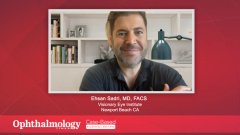
Patient Case #1: 58-year-old patient with open angle glaucoma utilizing minimally invasive glaucoma surgery procedure
Ehsan Sadri, MD, FACS, reviews the case of a 58-year-old male with open angle glaucoma utilizing minimally invasive glaucoma surgery procedure.
Ehsan Sadri, MD, FACS: Hi everybody, my name is Dr Ehsan Sadri. I’m a board-certified ophthalmologist, fellowship trained in glaucoma, practicing in lovely Newport Beach, California. I am the founder and medical director of Visionary Eye Institute. I’m also the co-founder of Visionary Ventures, also located in Southern California. It’s absolutely my delight to be here with you, and an honor and a pleasure.
Our first case is a 58-year-old practicing vascular surgeon who had LASIK surgery in 1995. He was referred in for a glaucoma and cataract evaluation. He’s on maximal medical therapies, intolerant to other medications, as you can see, he’s on latanoprost and Combigan. His best-corrected visual acuity is 20/50; he does have dense arcus, which we’ll show in the next couple of slides. He presents with intraocular pressure of 16 mm Hg. We don’t know his range in the past, but presumably, it was higher. The corneal thickness test is 490 μm, and you can see the cup/disc ratio is 0.85 in the right eye and 0.9 in the left eye.
This is a startling example of his right optic nerve, and he is obviously, again, status post-LASIK. We don’t know his pre-LASIK, preoperative measurements and refractive error, but you can see from a physical examination that he obviously has high myopia, and it’s very tough to delineate where the disc vs the rest of the tissue is. But there’s a circle that I put there for us to be able to delineate where the cup-to-disc is.
This is visual field progressive loss; you can see it’s pretty remarkable and disconcerting that he’s presenting this way because he has loss of visual field functionality in both eyes. And he’s obviously a very reliable patient on examination. For this patient, you can see he underwent cataract extraction surgery with monofocal lens implants. We did an OMNI trabeculotomy, goniotomy, and eye stents in both eyes. His intraocular pressures now are pretty steady, between 10 and 12 mm Hg, which is actually the target for this patient, and his best-corrected visual acuity is 20/20. He’s still practicing.
Transcript Edited for Clarity
Newsletter
Don’t miss out—get Ophthalmology Times updates on the latest clinical advancements and expert interviews, straight to your inbox.
















































